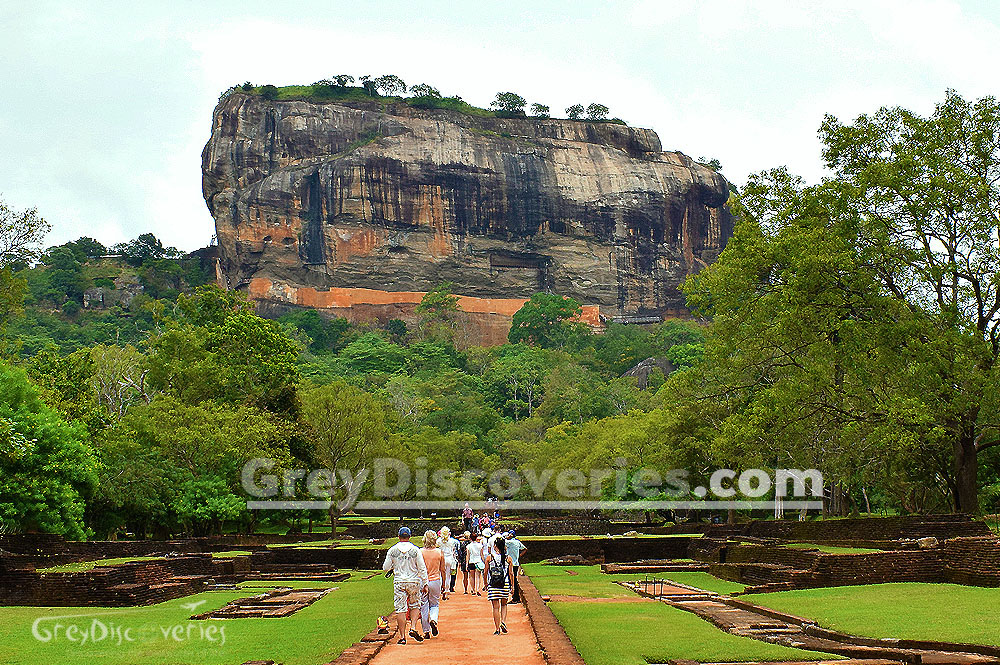Towering in the vast forests of central Sri Lanka is an ancient rock fortress called Sigiriya which is unique of all historical monuments in the country. This massive column of rock draws the attention of tourists even from a distance because of its dramatic spot.
Sigiriya dates back from the prehistoric period where traces of human habitation for over thousands of years ago have been discovered. Caves were found surrounding the rock which suggested that Buddhist monks inhabited the place as early as the 1st century BC. It is one of Sri Lanka’s UNESCO World Heritage sites. According to history, during the 5th century King Kassapa decided to build his Kingdom at Sigiriya. He constructed a fortress complex consisting of a palace at the rock’s summit, a lion’s gate at the northern mid-section of the rock, gardens, pathways, ponds, moats, and fortifications. Sigiriya clearly demonstrates Sri Lanka’s engineering skills and advanced urban planning during the ancient times.
SIGIRIYA’S FEATURES
The Water Gardens
The visitors’ entrance to Sigiriya’s rock is situated on the western side where you will walk on a long alley bordered with water gardens. The entrance itself is impressive with the surrounding water gardens consisting of water pools, fountains, and remnants of old structures. These water gardens have been recognized by the world because it exhibits sophisticated hydraulic technologies recorded to have existed centuries ago and still working even up to the present.


The Boulder Gardens
After passing through the water gardens, the visitors will be welcomed by the boulders of rock interlinked with series of winding pathways. This is the start of the ascent towards the ruins of the palace perched at the summit.


Sigiriya Frescoes
Expect for hundreds of steps before reaching the spiral staircase leading to an iron platform where the frescoes at the western mid-section of the rock could be viewed. The frescoes were painted at the depressions of the rock face. It depicts female figures where the identities were not really confirmed. Photography here is strictly prohibited.

Mirror Wall
After viewing the painting gallery, there is a stairway which leads visitors towards the direction of the mirror wall just below the gallery. It was made of brick masonry which was originally very well polished that the King could see himself through it. Perhaps for that reason, it is called as such. At present, the wall is covered with writings which belong to the period as early as 7th century. This graffiti proves that centuries ago tourists come to visit this place and wrote verses on the wall. The letters were written in an ancient Sri Lankan language where it describes the visitors’ admiration to the place.

The Lion’s Paw Terrace
On the northern mid-section of the rock, along the path of mirror wall, is a terrace with two gigantic paws of a lion. It was said that during the reign of King Kassapa, there was a huge figure of a lion on that area which served as a gateway to the palace at the top. However, the lion’s head and shoulders sculpted against the rock wall have collapsed and what now remained are the two colossal paws. The figure of the lion symbolizes power and authority of the kingdom during that time. The name “Sigiriya” which means, the Lion Rock, was perhaps derived from the structure of the lion that has been found there.

The Ruins of the Palace
The main palace perched atop the rock extends an area of 1.5 hectares. The foundations of the palace are still intact with gardens and ponds beautifully laid out.


THE CLIMB
With a height of nearly 200 meters, climbing this rocky plateau is not for the faint of heart. It was not an easy climb with hundreds of steps to reach the summit. The humid and hot weather makes it more difficult to move up. It is better to start climbing early in the morning or late in the afternoon to avoid the scorching heat of the sun. The monument opens at 7 in the morning and closes at 5:30 in the evening. When I visited this famous Sigiriya fortress, I was not really ready for the climb. My outfit was not actually suited to climb steep stairs but there was no time to back out after traveling for more than 3 hours just to see the place. At least, I am wearing a good pair of shoes during that time so I still felt comfortable.

We reach there at 11 in the morning and the weather conspired with us to reach the summit. It was somehow cloudy and the cool breeze kept us going. When we arrived at the lion’s paw terrace, there was a feeling of relief because we were already halfway to the target. But upon seeing the staircase, it made me decided to rest for few minutes to regain my energy.

The iron staircase, anchored to the surface of the rock, is narrow and nearly vertical where those who have fear of heights must think twice. After consuming a bottle of water, I decided to go ahead to finally reach the top. My grip on the hand rails was really tight while taking those steps that I thought would not finish. I could hear my heart pounding and my gastrocnemius started to pain but I saw only few steps left, so I continued until I get there. Reaching the peak was indeed a test of endurance but getting there is such an achievement and satisfaction.
The palace at the top occupies an expanse of more than 1 hectare where the ruins are still evident with the gardens, ponds made of bricks, and a large pool. The remnants of the palace will make your imagination soar and go back in time. The landscape was breathtaking with the lush forests and the water gardens below. It was relaxing to spend some time there at the summit to enjoy the vista and admire the beauty of nature that surrounded us.


THE DESCENT
Getting down is much easier with less effort exerted. On our way down, we passed by the terraced garden and took some awesome photos of Sigiriya. There were monkeys everywhere but I believe they are harmless, though sometimes they run after your food. As we were following the signboards towards the car park, we were able to catch a glimpse of the audience hall, asana cave, and cobra hood cave. These caves were intended as dwelling places for the Buddhist monks during the early days.



We knew we reach the end of our hike when we were approaching several shops selling souvenirs and mementos of Sigiriya. Luckily, we end up the hike without being attacked by wasps. There are several warning signs that say: “Be silent, WASPS.” Well, maybe the wasps were not around when we visited their territory. Only the chipmunks and the monkeys were guarding the area and they were nice to us.


Tip: The entrance fee for the monument is 30 USD for foreigners including a complimentary entry to the museum. You could pay also in Sri Lankan rupees which is equivalent to 3900. Entering the Sigiriya Museum before the climb will help you understand the history of the rock and know its archaeological significance. Once you decided to visit this famous rock fortress, make sure to bring plenty of water, hat, towel and an extra shirt. The climb would be tedious so be prepared with your comfortable clothes and a good pair of walking shoes.
It is still early to end the day here. After finishing our hike on top of the Sigiriya Rock, it’s time to have our buffet lunch near the area. We need to refuel our stomach because we are up to another climb. It’s the Dambulla Cave Temple, another Sri Lanka’s UNESCO World Heritage Site. Check out more of Dambulla Cave Temple here.







Wow!! Add this to my bucket list! It looks and sounds absolutely amazing.
Hi Jane, thanks for dropping by. Indeed it is truly amazing!
Wow! I love your photos! They’re so captivating! 🙂
Will include this too in my bucket list! Wonderfu!l!